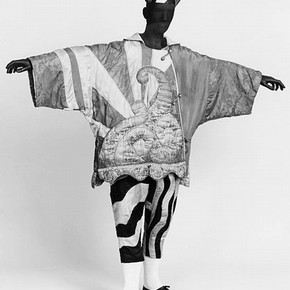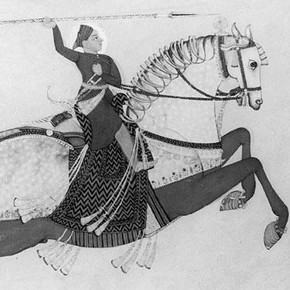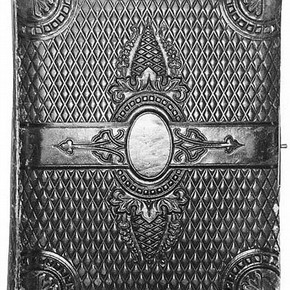Conservation Journal
January 1999 Issue 30
RCA/V&A Conservation Course Abstracts
This Journal provides a welcome opportunity to present examples of work by the students on the RCA/V&A Conservation Course, both through the articles they contribute and this occasional series of abstracts. On looking back over previous issues, it seems that this preface often includes an apology for the long interval between abstracts, and the lack of space to present more.
This problem is becoming more pressing as the Course expands and the body of work grows at a commensurate rate. Although the student abstracts are generally well received, they can only be included at the expense of other articles and their publication tends to be somewhat haphazard. The time has come to review this method of dissemination, especially now that the internet offers such exciting potential for sharing information. If readers have any constructive comments, they are welcome.
For the present, though, our intention is still to publish abstracts, in as complete and timely a way as space permits. In this issue you will find a selection of abstracts representing the three areas in which MA students submit essays for assessment: History of Art & Design, Science and Materials & Techniques. For two students, Elizabeth-Anne Haldane and Anna Hillcoat-Imanishi, all three essays are included, giving an idea of the progression of academic work and how it builds into a useful source of reference for the students. The subjects are often of interest to a wider audience and copies of student work may be consulted in the V&A Conservation Department Library by arrangement.
History of Art and Design Essay
Laura Jane Bennett
Applied Arts and Social History Object Conservation
The Visual Impact of the Festival of Britain 1951
April 1997, 6870 words
The Festival of Britain in 1951 set out to re-establish an art and design identity for Britain after the Second World War. It offered a means to re-assert national pride and celebrate cultural identity after the constraints of war and was a chance for a new Labour government to lay out blueprints for the revitalization of the British economy and for future success.
The Festival of Britain illustrates a turning point in the history of art and design. It played a vital role in the development of the industrial designer and the creation of well designed products available to all. The consequences of war gave the Festival a dramatic backdrop against which to devise a plan for a new Britain. But to what extent was the visual impact of the Festival new and optimistic? Did it succeed in capturing the aspirations of the people of post-war Britain?
This essay examines the influence of war and the society it created on art and design in the 1950s, as illustrated by the Festival of Britain. It evaluates the motives of artists and designers in an attempt to explore the development of art and design within contemporary popular culture.
Elizabeth-Anne Haldane
Textile Conservation
Stylistic Developments in the Costumes of the Ballets Russes - from Bakst to PicassoJanuary 1997, 6500 words
The Ballets Russes of Sergei Diaghilev first performed in Paris in 1909 to great artistic acclaim. Their productions were to influence not only the development of ballet in the West - revolutionizing the approach to music, choreography and stage design - but would also have significant effects on fashion and interior design, heralding the age of Art Deco.
This essay looks at stylistic developments in the costumes of the Ballets Russes between 1909 and 1917. Diaghilev's company produced a wide variety of ballets and involved many of the leading artists from the early 20th century. This essay focuses on three productions, each of which proved to be stylistically important: Scheherazade from 1910 designed by Leon Bakst, Le Sacre du Printemps from 1913 designed by Nikolai Roerich, and Parade from 1917 designed by Pablo Picasso.
The importance of the sets and costumes to the rest of the production is explored, and the work of the different artists for the three ballets compared and contrasted with a view to explaining the diversity of styles in the costume designs. Finally the reasons for the company's changes in stylistic direction are examined.
Anna Hillcoat-Imanishi
Paper Conservation
Nimbus. The Halo in the Art of the Indian Subcontinent with an Emphasis on Mughal Miniatures
January 1997, 5500 words
The paper presents nimbuses in their various forms as they occur in the arts of the Indo-European cultural area. The essay aims to elaborate on the use of nimbuses in Mughal miniature paintings and investigate the origins of the nimbus in the repertoire of the Mughal court painter. The main focus of the investigation lies in the question of whether the Mughal nimbus is related to Christian nimbuses or can be traced back to a tradition of nimbus painting within Islamic art.
After exploring the meaning of the nimbus and presenting the main forms of occurrence, examples of Christian nimbuses are presented and discussed. Similarly, nimbuses in the arts of the Indian subcontinent are illustrated. Finally, Persian art is investigated. In the second part of the paper Mughal nimbuses are presented and discussed in detail.
A conclusion presents the outcome of the investigations, and attempts the interpretation of the Mughal nimbus.
Laura Jane Davies (nee Bennett)
Applied Arts and Social History Objects Conservation
Horn of Plenty. The History of Horn Working and its Occurrence in Social History Collections
6720 words
Horn has been utilised throughout history because it was a readily available waste product from butchery. As a poor man's material, it represents a valuable tradition of folk craft and source for social history. Horn is thermoplastic and by the nineteenth century, production processes involving pressing and moulding were highly developed. This knowledge of horn-working contributed to the development of synthetic plastics.
The essay begins with a description of the physical properties of horn and the way these are related to the structure and chemical composition of the material. This section also places horn in its context as a skeletal material, by comparing it with horn, ivory, bone and antler. The identification of these materials is very important for historical evidence and conservation implications.
Two distinct types of craft represent horn-working, and these are described in the second part of this essay: those which utilize the natural shape and qualities of horn, and those which manipulated these characteristics. The former are associated with domestic craft while the latter required specialist knowledge and equipment. The majority of the objects examined for this essay are from the collection of the Worshipful Company of Horners kept at the Museum of London.
Science Essays
Elizabeth-Anne Haldane
Textile Conservation
Cellulose and its Derivatives
April 1997, 6700 words
This essay begins with a general discussion about the natural polymer cellulose, looking at its molecular composition and bonding in order to understand how it behaves as part of a larger structure.
Although wood, paper and cotton are mainly composed of cellulose, they have very different mechanical properties. To understand the reasons for these differences, the natural and man-made structures which are formed by cellulose in wood, paper and cotton are investigated and compared.
The second part of the essay deals with cellulose which has been chemically modified. Following a brief historical outline of the development of cellulose derivatives, four are examined in detail. These examples are particularly relevant to textile conservation. Cellulose nitrate, in the form of Celluloid, was the first 'plastic' and can be found in textile and dress collections as trimmings or accessories. Cellulose acetate is widely used as a textile fibre as is viscose rayon, which is actually a regenerated cellulose. The last example is sodium carboxymethylcellulose, which is used during the washing of textiles in order to prevent the redeposition of dirt. The chemistry of the manufacture of these materials is described, and their properties and applications are discussed and compared.
Anna Hillcoat-Imanishi
Paper Conservation
Substantia Aut Accidens? An Investigation into Historical Theories on Light and an Explanation of the Production of Colour by Organic Molecules Employing the Orbital Model Based on Quantum Mechanics
April 1997, 7800 words
The paper analyses the interaction of matter with electromagnetic radiation, in particular how colours are produced in organic molecules. A concise overview of the evolution of various theories of light, from the beginnings in classical philosophy to the quantum theories of the twentieth century, finishing with the concept of wave-particle duality is given. The model used to describe colours relies on an understanding of certain theories on the nature of light in general, which are discussed in part one of the paper. Part two gives a brief outline of the structure of atoms and bonding mechanisms on organic molecules as a precursor to the model of colour explanation. The nature of colour and how colours are produced within the molecules are discussed in part three. The paper concludes with a summary of the findings.
Materials and Techniques Essays
Roger Griffith
Furniture Conservation
Materials and Techniques of Tubular Steel Furniture
October 1996, 6975 words
This essay outlines the materials and techniques of tubular steel, and also briefly outlines the history and origins of tubular steel furniture. The paper primarily highlights furniture of the 1920s and 1930s, when tubular steel was the material of the future. It was in these years that tubular steel was of the greatest significance as an industrial material. No attempt has been made in this essay to cover other types of metals used in the production of tubular furniture. The paper concentrates on the basic processes of steel tube production and applied surface treatments. Research for this paper revealed the lack of information from the British Furniture Companies of the 1920s and 1930s. For both Pel and Cox & Company, there is virtually no production documentation; Pel lost everything in a fire in the 1950s and Cox, after its take-over by Pel, lost its archival material.
Anna Hillcoat-Imanishi
Paper Conservation
Minium, Gold and Cow's Urine. The Materials and Techniques of Mughal Miniatures
December 1997, 10800 words
This study provides a survey of the materials and techniques used to paint Mughal miniatures as described in the literature. Observations made while examining a page of the Akbarnama manuscript supplement the information from documentary sources. Pigments are illustrated by samples of the actual pigment painted out on suitable paper using a traditional binder. The techniques of painting are illustrated by photomicrographs taken of the Akbarnama page. The results of the survey, together with observations based on the practical experiences, are discussed in the conclusion. Implications for future research and conservation practice are considered.
Elizabeth-Anne Haldane
Textile Conservation
Elastic Fantastic to 'Lycra Sensations'
October 1997, 7100 words
Elastomeric fibres include natural rubber, synthetic rubber and elastanes. In this essay the properties of these different materials are described, and the methods by which they are manufactured into textile fibres are discussed. In addition, the techniques for incorporating these fibres into fabric structures are explored.
The essay is divided into two sections. The first section is about natural rubber, which was first used in conjunction with textiles early in the nineteenth century. Early inventions for elasticated fabrics, the vulcanisation of rubber, and the introduction of the first continuous rubber filament 'Lastex' are discussed. The second section touches on the variety of synthetic rubbers which were created when there was a shortage of natural rubber during the World War II, then looks at 'Lycra' which was the first of the polyurethane elastane fibres (1959).
The methods of manufacture and differences between various elastanes are described, in particular the latest elastane fibres being developed in Japan. Finally, the ways in which these fibres can be incorporated into fabric structures, and the different effects which can be achieved by varying the direction and/or amount of elastane used, are examined.
Shayne Lang
Furniture Conservation
English Japanning: 1660-1700
December 1997, 9000 words
This paper examines two early technical treatises in order to consider the materials and techniques used to create japanned surfaces on early English furniture. Relevant sections of John Evelyn's Silva (1664) and Stalker and Parker's A Treatise of Japanning and Varnishing (1688) are systematically evaluated in order more fully to understand English japanned surfaces of the late seventeenth and early eighteenth centuries. These were created using complex, multi-layered spirit varnish surfaces which imitated the translucence of oriental lacquer. It provides some historical context before discussing the preparation of japan grounds and the decoration applied to them.
Jane Rutherston
Book Conservation
Victorian Album Structures
October 1996, 6942 words
This essay takes a look at the development of album structures during the Victorian period, a time of innovation and expanding commercialism. Album evolution was influenced by advances in technology and the introduction of new materials, combined with the quest for new designs in which to mount the increasingly popular photographs, scraps and other ephemeral material.
Spurred by the need to meet public demand, it was necessary to develop techniques that could be mass produced using inexpensive materials.
Sophia Strang Steel
Metals Conservation
The Surface Embellishment of Metals (With an Emphasis on Colour Contrasts)
October 1996, 7120 words
The surface enrichment of metals could be interpreted as increasing the precious metal content at the surface of a metal object or as an increase in decorative value. This paper does not distinguish between the two issues but does concentrate on the techniques for creating colour contrasts. Evidence of the contrasting of colours in metals goes back to the second millennium BC where precious metals were inlayed into patinated alloys. The methods of creating coloured surfaces on metals are varied and the potential applications in design almost limitless.
This investigation of surface embellishment is not so much a survey of the techniques of fabrication, but an overview of coloured surface structures which might be useful to the conservator. The main areas covered are the application and depletion of surface layers, the lamination of metals and the creation of stable surface films (chiefly in relation to the patination of alloys). Alloys are used extensively throughout the world for many functional and decorative purposes, so the essay gives a brief description of the nature of alloys and the relationship of their composition to properties.
January 1999 Issue 30
- Editorial - Change, Access and Permanence
- Consolidation of Painted Surfaces. A Workshop led by Sandra Grantham, 11th September 1998
- The Novels of Charles Dickens; Bound to Last? The Structural Evolution of a Manuscript's Bindings
- Non-Destructive Pigment Analysis Using Raman Microscopy
- An investigation into the archival properties of colour photocopies and inkjet prints: Summary of a project undertaken at Camberwell College of Art as part of a BA in Paper Conservation, Spring 1996
- 24th Annual Conference of Canadian Association for Conservation of Cultural Property in Whitehouse, Yukon, 27-29 May 1998
- Science Surgery
- RCA/V&A Conservation Course Abstracts
- Issue 30 Printer Friendly Version


